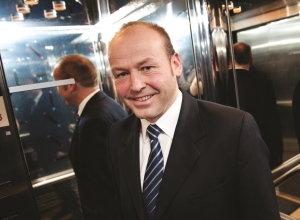DNB reopens AT1 post-DB part II with $750m
DNB attracted over $5bn of demand and 350 accounts to a $750m perpetual non-call 2022 Additional Tier 1 transaction on 11 October that was the first AT1 benchmark in dollars or euros in over a month and the first since renewed concerns around Deutsche Bank had hit sentiment.
Only two benchmark AT1 transactions had been launched in either dollars or euros since the summer break, with Barclays having issued a $1.5bn deal on 24 August and Société Générale $1.5bn on 6 September.
DNB had indicated at the start of the year that it planned to approach the market with a new AT1 transaction in 2016 to fill up its 1.5% bucket, but market conditions had earlier in the year not proven accommodating, according to Thor Tellefsen, head of long term funding at the Norwegian bank (pictured).
“Deutsche Bank upset the whole market in springtime,” he said, “then there was a small rally in the summer, but then Deutsche came and upset it again. So it was a question of being prepared and ready to go, and after the market calmed down after the second Deutsche upset we decided to go to the market.
“There were a lot of unforeseen things that could have happened in the latter part of the year — the presidential elections, Fed and ECB meetings, etc — so it was a good idea to get it done. And in the end we thought it was a great outcome.”
Leads Bank of America Merrill Lynch, DNB, Goldman Sachs, Nomura and UBS went out with initial price thoughts of the high 6s before moving to guidance of 6.5%-6.625%, will price in range, and ultimately set the level at 6.5%. The order book totalled $5.2bn, comprising around 350 investors, against a deal size of $750m (Eu706m, Nkr6.42bn), which Tellefsen said is the amount DNB needed to fill its 1.5% AT1 bucket.
“It came out at a very good level,” he said. “Since the last AT1 transactions the market had been quite turbulent, so this transaction represented something of a reopening of the market and the price visibility wasn’t that great.”
“It traded very well and continued to tighten,” he added, “which is probably not surprising with an order book of $5.2bn for a $750m issue. It was very encouraging that there were more than 350 different investors in the book.”
Dollars were chosen for two reasons, according to Tellefsen.
“The main reason is that we need dollars more than we need euros, because dollars suits our balance sheet better and gives us a hedge versus Norwegian krone/dollar movement,” he said. “The second thing is simply the after-swap cost: the cost of the dollar transaction was significantly lower than a euro transaction would have been.”
Outstanding DNB AT1 were caught up in previous bouts of volatility partly because of headlines around the oil price — something the Norwegian issuer discussed in marketing ahead of the new issue.
“It was of course important for us to give an update on the Norwegian economy and show the market that in spite of the oil price drop Norway is still doing much better than most countries in Europe,” said Tellefsen. “Norway still has one of the lowest unemployment levels, is still one of the few countries to run a budget surplus, and our oil fund is actually still increasing — although not as fast as previously.
“And the fact that we still have a central bank rate of +0.5% should also tell you something about the Norwegian economy.”

